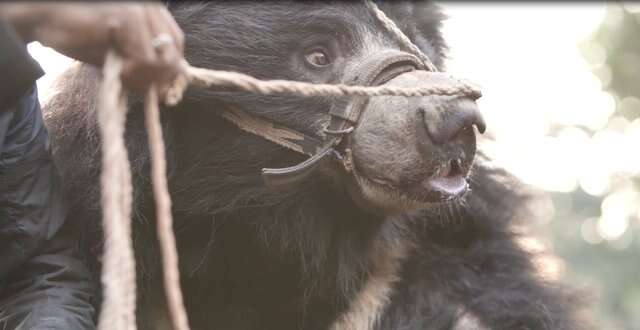For nearly two decades, Rangila and Sridevi lived a nightmare.

Snatched from the wild as helpless cubs, torn away from their mothers, they were sold into a life of cruelty disguised as entertainment. A burning hot rod pierced their noses, a rope threaded through raw wounds so they could be yanked and controlled. Every tug of that rope meant pain. Every performance meant submission.
For years, they were forced to “dance” for the amusement of strangers. Tourists clapped, children laughed, but behind those dark eyes was only fear, pain, and exhaustion. Their paws shuffled not to music, but to the rhythm of suffering.
Rangila, a 19-year-old male, and Sridevi, a 17-year-old female, became the last known “dancing bears” in Nepal. Their misery was supposed to be endless—until a rescue mission changed everything.
The Night of Hope
On December 19, in a joint operation with the Jane Goodall Institute of Nepal, local police, and animal welfare advocates, their owner was tracked down through his mobile phone. The rescue team arrived in Iharbari, hearts pounding with urgency.
What they found broke them.
The bears were cowering, pacing nervously, sucking their paws in signs of deep psychological trauma. Their massive bodies, meant to roam forests and rivers, were instead worn down by years of captivity and abuse. The ropes through their noses still bore witness to the torture that had shaped their lives.
It took careful coordination, patience, and courage, but finally—after hours of effort—Rangila and Sridevi were freed from their ropes.
For the first time in 17 and 19 years, they were no longer under the control of cruelty. They were being taken somewhere safe.

From Horror to Safety
As the rescue vehicle rumbled away toward Parsa National Park, the bears were quiet—still wary, still uncertain. Decades of abuse don’t vanish in a moment. But they were on their way to a place without ropes, without shouting crowds, without pain.
The team knew it would take time. These bears had been conditioned to fear, not to trust. But here, at last, was the beginning of healing.
Neil D’Cruze, a wildlife expert, explained: “Rangila and Sridevi have suffered for too long in captivity since they were poached from the wild.”
For Manoj Gautam of the Jane Goodall Institute of Nepal, the rescue meant something even greater: “We are thrilled that the last two known Nepali dancing bears have been rescued from their lifetime of suffering.”
With this single act, an entire chapter of cruelty in Nepal’s history closed.
The End of Bear Dancing in Nepal
Bear dancing is one of the most heartbreaking forms of animal exploitation. Cubs are stolen from their mothers, subjected to brutal training methods, and forced to perform unnatural behaviors. Their lives are stripped of everything a bear should know—freedom, wilderness, family.
For decades, advocates have fought to end this cruel practice, one country at a time. It was eradicated in Greece, Turkey, and India. Now, with Rangila and Sridevi’s rescue, Nepal joins that list.
This was more than a rescue. It was history.
But the Fight Isn’t Over
While Nepal’s bear dancing trade has ended, other horrors remain. Across Asia, bears still suffer in the blood sport of bear-baiting, forced to fight against dogs while restrained. In the bear bile industry, as many as 22,000 Asiatic black bears are confined in tiny cages, with permanent holes in their stomachs so bile can be extracted for so-called “medicine.”
Rangila and Sridevi’s story is a victory, but it is also a reminder: the work is not done.
A Celebration of Compassion
As 2017 drew to a close, this rescue marked more than an end—it marked a beginning. A new life for two bears who had known only chains. A new milestone for a country that chose compassion over cruelty. And a reminder to the world that change is possible when people care enough to act.
For Rangila and Sridevi, freedom is finally here. No more ropes. No more commands. No more forced “dances.” Just the chance to live as bears were meant to live.
And for those who helped them, and those who shared in their journey, the message is clear: kindness has the power to end suffering—and to set lives free.




